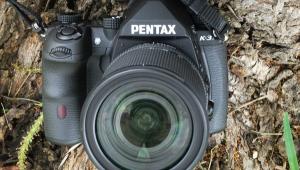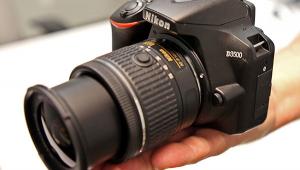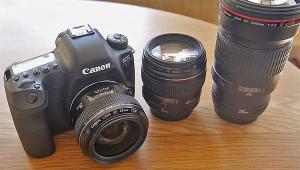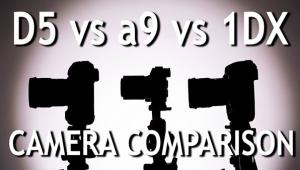Under The Stars: Working With The Canon EOS 60Da
During two late May evenings in 2012 I had an opportunity to work with the Canon EOS 60Da (hereafter “60Da”) camera to see how well it performs with respect to astrophotography. This happened during a very small window between the solar eclipse of May 20, 2012, and the transit of Venus on June 5, 2012. Needless to say, my time was stretched to a breaking point that I have rarely experienced in my life. However, I am glad to report that evaluating the 60Da did not add to my stress level as it was easy to use as well as enjoyable, given my specific goals.

My main objective when using this camera and detector was to determine its response to nebulae that emit light strongly in the red part of the spectrum (the so-called Hydrogen-alpha wavelength of light). Traditionally, detectors used in consumer cameras use pixel filters that block this part of the spectrum. Otherwise, these longer, reddish wavelengths of light (especially infrared) are permitted to pass through all of the color filters and destroy the color balance. The problem is that these wavelengths of light are exactly the red colors most nebulae glow.
The solution is to modify (or remove) the infrared filter, thereby adjusting the passband and effectively increasing the sensitivity of the detector for astrophotography. The 60Da I used had this modification so I sought out three well-known targets to capture and process. The first two objects were small so I attached the 60Da to the back of the 0.8m Schulman Telescope (#1) that is used in the public outreach programs at the Mount Lemmon SkyCenter in Arizona (http://skycenter.arizona.edu). I fitted a Canon T-ring adapter with a 1.25” nosepiece to the front.

All Photos © Adam Block
Typically in astrophotography the camera body is not used in the acquisition of the data. Exposure times are generally several minutes or more in duration. Instead, users take advantage of the camera driver and use software that controls the camera. I used Maxim DL (Cyanogen) to control the 60Da and take many 3-minute exposures sequentially of these objects.
The first target of interest was a globular star cluster called M13 (#2 and #3). It is a ball of over 100,000 stars that lies some 30,000 light years away. This kind of object makes an excellent litmus test to verify the detector has no significant flaws or artifacts in low-light level conditions. Shown are two 30-second exposures at ISO values of 1600 (#2) and 3200 (#3) saved as high-quality JPEG images with no other processing.


The increase in the gain of the chip by doubling the ISO value is readily apparent. The final brightened result (#4) has good fidelity in star color. This shows that the default colorization factors normalize the chromatic response of the chip. This is advantageous for those enthusiasts who wish to show color images of deep sky objects quickly without any other processing in a Raw format. In addition, saturated stars measured 15,308 Analog to Digital Units (ADU), which nearly fills the 14-bit advertised bit space with potentially 16,384 brightness values.

The second object I worked on was the famous Ring Nebula. This bubble of gas is created by a dying star that sheds its outer layers of gas. The central star (the exposed core, a white dwarf) emits intense ultraviolet light that the bubble gas re-radiates in specific vibrant colors (#5).

This data set consisted of eight exposures of 3 minutes each. I chose to keep the ISO setting at 3200 because higher values resulted in noisier images that would require a greater number of sub-exposures to achieve a similar Signal-to-Noise (S/N) ratio. The images were processed using CCDStack (CCDWare) by first de-bayering the data and extracting each image into a triad of red, green, and blue pixel images. For the 60Da, the Bayer pattern has the red pixel at top left with the blue pixel opposing it at the bottom right and the two green pixels are along the other diagonal. The data for each channel was then processed in the customary manner by registering, normalizing, rejecting outlying values by statistical analysis, and finally computing the mean values. Since these images were not dithered between exposures, the presence of too many hot pixels would detract from the image. The 60Da was found to have a very small population of hot pixels which were easily taken care of by a hot pixel filter.
The three combined mean images for red, green, and blue data were then finally blended to render the image shown in #5. Note the characteristic teal for the central region glows strongly while the red outer shell is distinct and not muddied by other colors.
The low noise of the 60Da detector also captured the extremely dim components of this astronomical vista. Both the very faint outer halo of the nebula as well as the background galaxy (IC 1296) are features sought after by all amateurs who take pictures of this field. Hints of the color in this outer halo are shown in #6, which was a surprise for the reviewer. Perhaps equally impressive is the detection of spiral structure in IC 1296—a galaxy more than 200 million light years away. Longer exposures would of course reap rewards for a striking image of this pair.

Since the Ring Nebula is an emission-line object, my last target was to capture a HII region that more broadly exemplified the Hydrogen-alpha (H-alpha) emission. I chose to work on the North American Nebula (NAN) in Cygnus. This direction toward the plane of our galaxy is filled with large glowing clouds of hydrogen gas. In order to capture even a small fraction of the NAN I used a smaller, TeleVue telescope with an aperture of 127mm. This high-quality refractor is currently strapped to the side of the Schulman Telescope (not shown). While the focal length of the Schulman Telescope is 5600mm, the TeleVue refractor is only 630mm. Stars at this focal length are entirely undersampled and provide a sensitive test for the 60Da’s pixel filters and interpolation aberrations of the Bayer matrix.
Star edges are relatively clean and devoid of significant color fringes as shown in #7.

In order to demonstrate the difference in the response of the 60Da with a regular chip, see #8 and #9.


As can be seen, the 60Da detects the red wavelengths of light significantly better than an unmodified detector (an EOS 5D Mark II through a telescope with a 160mm aperture). Interestingly, even the larger telescope, with more than two hours of exposure time represented in #9, shows virtually no signs of the diffuse H-alpha emission of the NAN. In some sense the extra color contrast in the 5D image might make it more compelling. However, it isn’t the “natural” color of this object. The 5D result is akin to taking a picture of your family and friends and having their faces and body appear green-blue. The blue light, called H-beta emission, seen in the 5D image, is also in the 60Da image, but with the additional H-alpha glow it serves to create a brighter magenta-pink that characterizes this nebula. This nebula is bright enough that some red emission shows in the 5D image, but in general most deep-sky objects of this type would be rendered invisible without the modification designed in the 60Da.
Never having used a modified D-SLR before, this reviewer was impressed with the performance of the 60Da in terms of low noise and increased red sensitivity compared to unmodified detectors. There were no issues in controlling the camera using the standard EOS driver and software to communicate with it. My conclusion is that this camera is a good entry-level choice for pursuing the art and science of astrophotography.
About The Author
Adam Block’s lifelong goal to be an astronomer began at the early age of 4. He specifically selected the University of Arizona to continue his pursuits and graduated with a B.S. in Astronomy and Physics in 1996. He spent the next nine years developing and administering public outreach programs at the National Observatory (Kitt Peak). Since 2007 his dream to create the foremost public outreach experiences in astronomy is being realized with a return to the University under Steward Observatory and the College of Science at the Mount Lemmon SkyCenter.
Block is most well known for his abilities to speak and communicate difficult concepts in astronomy in simple and creative ways. Over the past 15+ years he has hosted many thousands of evenings for the public and strives to maintain quality programs that are fresh and exciting with unflagging enthusiasm. Block is also recognized around the world as a leading astrophotographer. The images he produces as part of public outreach programs are published in magazines, books, posters, and widely on the Internet. His images have graced NASA’s “Astronomy Picture of the Day” website more than 60 times and have been used as reference images by amateur and professional astronomers alike. In 2012 he was the recipient of the “Hubble Award” from the Advanced Imaging Conference—one of the highest awards for work in astrophotography that is recognized around the world.
For more information about Adam Block, please visit www.shutterbug.com/content/adam-block-astrophotographer.
















































